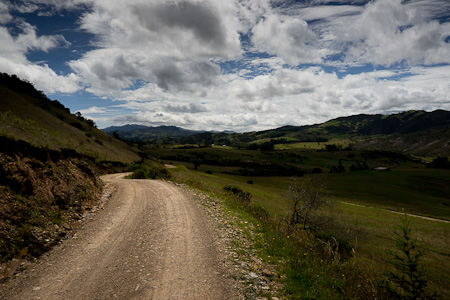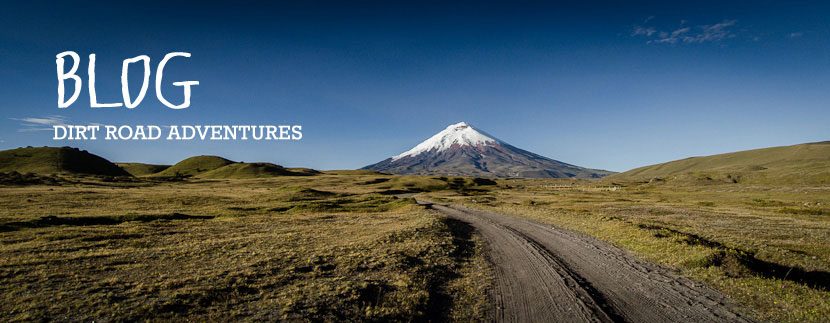The last push from Villa de Leyva to Bogota…

A couple of hours from Villa de Leyva lies the village of Raquira, known for its colourful murals and tourist trinkets.

Nice hat, lady.

Muy Colombiano.

Chilling out in the main square.

A long and meandering climb took us over a distant ridge and back onto dirt again.

There were few settlements along the way, just remote pottery works guarded by yappy dogs and the odd fincita.

Then it was easier going, along an undulating ridge with far reaching views. Again, there was very little traffic, the odd passenger-laden jeep bounced by with a wave and a blast of the horn.

Arno, Hermon and one of his daughters, standing on the septic tank Arnaud unknowingly camped upon. Hermon is a foreman in one of the vast, grungy, coal mines that pock the landscape between Guacheta and Lenguazaque, pumping noxious fumes into the air. This short stretch can't claim to be the most beautiful riding in the country, but it reflects another side of Colombia.

Leaving our lumpy, and a touch smelly, campsite for the road again.

Likewise, deserted-by-day Lenguazaque wasn't the picture perfect settlement we'd become accustomed to.

Stained with soot and lined with bars, it was a real miner's town.

Still, the hills all around were beautiful.

Yet another climb...

And yet more idyllic riding. Colombian backcountry touring is definitely up there with Mexico's Sierra Madre trails.

The descent towards Hato Grande.

There goes Arnaud and his pod - which is actually called Bob.

A tempting camping spot. This one smelt better than the last...

Taking a break at a dusty junction. Our Mapas de Ruta road atlas became a little patchy in these lesser-travelled parts, so local insight - which might just be a vague swipe of the arm in a general direction (Derecho! Straight on!) - was relied on.

The main square in laid back Nemocon, famed for its salt mines.

And the Salt Cathedral in nearby Zipaquira. Proudly sponsored by Coke.

Begun in 1950 and updated at various points, the Salt Cathedral is an underground Roman Catholic Church. It's made up of a vast labyrinth of surreally lit cloisters and towering prayer rooms that burrow 180 metres deep into the earth.

Various side temples are to be found down darkened corridors. The Salt Cathedral is an active place of pilgrimage; three thousand people gather in the main hall on Sundays.

Closing in on Bogota. From here, we were back on pavement.

Luckily, a cycle lane shielded us from the trucks that rumbled past for much of the way, until things became more of a frenzied free-for-all closer to the city.

There, we were lucky enough to be put up by friends of Arnaud for a few wonderfully restful days. We ate like kings. This plate of traditional Ajiaco was rustled up upon arriving, made with rice, chicken, cream, olives and corn on the cob, infused with a herb called guascas. Delicious.

Banksy-style, street stencils.

Nadie gana: No one wins...

Murals on Septima, one of the main throughfares through the city.

The mean streets of Bogota. The city is considerably safer than it used to be, though there are plenty of parts best avoided, and pickpockets are a'plenty.

Discover your city - and how better to do that than by bike? The reason I wanted to be in Bogota at the weekend was to experience `Ciclovia´.

Ciclovia is event where a large portion of the city is closed to traffic between 8am and 2pm. And this isn't just a one off - it's every Sunday and festival day. The scheme was introduced in early 80s, currently covers 120km of routes and is being repeated all over Latin America. Incredibly, it's used by 30 per cent of its population - some 2 million people. It does beg the question: if metropolises as vast as Bogota, Caracas and Guadalajara can do it, why don't we see this in European cities?

Everyone was out and about. Young and old, bikers, runners, bladers and skaters, all taking to the reclaimed streets without fear of cars hurtling by. An amazing, inspiring scene.

There, we also met up with the Bike For Water crew, who I'd ridden with out of Mompox. Dutchman Michael was sporting this new mohawk for the onward journey.

Plaza Bolivar, the main plaza in downtown Bogota.

In the bike vein, Maria Clara, who we've been staying with, drew me these lovely sketches. Each serves as a reminder: to be present in the world (and not like a zombie), to think about what I am experiencing, and not to be forgetful. I'm always leaving behind my helmet, mitts, sunglasses, power cord, so now I have a checklist... Listo! The chicken bus, bellowing a cloud of Wa Wa, is the name of my trusty steed, from the Cuban slang for buses. These missives are now afixed across my handlebars.

Ciclovia is all about promoting improved, clean, city transport, a healthy lifestyle and closer communities. Various squares offered events such as aerobics and yoga. It's also chance for a little enterprising business too. Juices and snacks were on sale on every corner, and streetside mechanics were at the ready to patch up that fearful puncture. So no excuses!

Talking about enterprising individuals, this is just one of the hundreds of streetside operators who rent out mobile phones, seen here hanging with umbilical-like chains. It's 200 pesos a minute - about 10c.

Later, I went for a forray in the Candelario district, a beatnik part of town replescent in colourful colonial era houses, in various states of disrepair.

The Botero Museum, named after the Colombian artist Fernando Botero, born in 1932, and famous for his rotund portrayal of both day to day existence and current events (like his 2004 exhibition on the violence from drug cartels).

Bogota has some great museums, which are free or very cheap to enter. This little display in the Coin Museum made me think of the movie, Night in the Museum, where everything and eveyone comes to life after dusk...











I absolutely loved the ajiaco. I could eat it every day.
Loved this… all those street murals (amazing work and so colourful) I hear Bogota is a dangerous place to stay in so stay safe… amazing salt Cathedral… enjoyed your words and superb photos as always… (and it’s 5 am here) SO excited to see your post on my over loaded lap top… thank you… already looking forward to the next and would love a bowl of Ajiaco right now… ride easy… X
the museo d’oro was one of my favourites too! have to agree most cities could learn from Bogota – cycle lanes, ciclovia – cycling respect! 😉
Fantastic murals, love them 😉
This adventure you are taking us on, started out for me with a qucikie review of the GF1 camera on Digital Camera Reviews. It feels as if i am along for the ride with you. Your photography is wonderful, entertaining, and informative. The GF1 looks to be giving you great service. Thanks for the wonderful treat of letting us ride along with you on your journey.